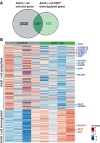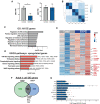SIX2 and SIX3 coordinately regulate functional maturity and fate of human pancreatic β cells
- PMID: 33446570
- PMCID: PMC7849364
- DOI: 10.1101/gad.342378.120
SIX2 and SIX3 coordinately regulate functional maturity and fate of human pancreatic β cells
Abstract
The physiological functions of many vital tissues and organs continue to mature after birth, but the genetic mechanisms governing this postnatal maturation remain an unsolved mystery. Human pancreatic β cells produce and secrete insulin in response to physiological cues like glucose, and these hallmark functions improve in the years after birth. This coincides with expression of the transcription factors SIX2 and SIX3, whose functions in native human β cells remain unknown. Here, we show that shRNA-mediated SIX2 or SIX3 suppression in human pancreatic adult islets impairs insulin secretion. However, transcriptome studies revealed that SIX2 and SIX3 regulate distinct targets. Loss of SIX2 markedly impaired expression of genes governing β-cell insulin processing and output, glucose sensing, and electrophysiology, while SIX3 loss led to inappropriate expression of genes normally expressed in fetal β cells, adult α cells, and other non-β cells. Chromatin accessibility studies identified genes directly regulated by SIX2. Moreover, β cells from diabetic humans with impaired insulin secretion also had reduced SIX2 transcript levels. Revealing how SIX2 and SIX3 govern functional maturation and maintain developmental fate in native human β cells should advance β-cell replacement and other therapeutic strategies for diabetes.
Keywords: diabetes mellitus; islet; pancreas; transcription factor; β cells.
© 2021 Bevacqua et al.; Published by Cold Spring Harbor Laboratory Press.
Figures







Similar articles
-
METRNL represses beta-to-alpha cell trans-differentiation to maintain beta cell function under diabetic metabolic stress in mice.Diabetologia. 2025 Aug;68(8):1769-1788. doi: 10.1007/s00125-025-06459-7. Epub 2025 Jun 10. Diabetologia. 2025. PMID: 40495021
-
Upregulation of HLA class II in pancreatic beta cells from organ donors with type 1 diabetes.Diabetologia. 2022 Feb;65(2):387-401. doi: 10.1007/s00125-021-05619-9. Epub 2021 Dec 21. Diabetologia. 2022. PMID: 34932134
-
Single-cell transcriptomics of human islet ontogeny defines the molecular basis of β-cell dedifferentiation in T2D.Mol Metab. 2020 Dec;42:101057. doi: 10.1016/j.molmet.2020.101057. Epub 2020 Jul 30. Mol Metab. 2020. PMID: 32739450 Free PMC article.
-
DNA Methylation Patterning and the Regulation of Beta Cell Homeostasis.Front Endocrinol (Lausanne). 2021 May 7;12:651258. doi: 10.3389/fendo.2021.651258. eCollection 2021. Front Endocrinol (Lausanne). 2021. PMID: 34025578 Free PMC article. Review.
-
[Transcription Factor PAX4: Role in Differentiation of Insulin- Producing β Cells during Pancreas Development and Association with Diabetes].Mol Biol (Mosk). 2025 Mar-Apr;59(2):189-200. Mol Biol (Mosk). 2025. PMID: 40558032 Review. Russian.
Cited by
-
Engineering islets from stem cells for advanced therapies of diabetes.Nat Rev Drug Discov. 2021 Dec;20(12):920-940. doi: 10.1038/s41573-021-00262-w. Epub 2021 Aug 10. Nat Rev Drug Discov. 2021. PMID: 34376833 Review.
-
HNF1α maintains pancreatic α and β cell functions in primary human islets.JCI Insight. 2023 Dec 22;8(24):e170884. doi: 10.1172/jci.insight.170884. JCI Insight. 2023. PMID: 37943614 Free PMC article.
-
Loci for insulin processing and secretion provide insight into type 2 diabetes risk.Am J Hum Genet. 2023 Feb 2;110(2):284-299. doi: 10.1016/j.ajhg.2023.01.002. Epub 2023 Jan 23. Am J Hum Genet. 2023. PMID: 36693378 Free PMC article.
-
Sine oculis homeobox homolog family function in gastrointestinal cancer: Progression and comprehensive analysis.World J Clin Oncol. 2025 Jan 24;16(1):97163. doi: 10.5306/wjco.v16.i1.97163. World J Clin Oncol. 2025. PMID: 39867730 Free PMC article. Review.
-
Transcriptional mechanisms of pancreatic β-cell maturation and functional adaptation.Trends Endocrinol Metab. 2021 Jul;32(7):474-487. doi: 10.1016/j.tem.2021.04.011. Epub 2021 May 21. Trends Endocrinol Metab. 2021. PMID: 34030925 Free PMC article. Review.
References
Publication types
MeSH terms
Substances
Grants and funding
- R01 DK107507/DK/NIDDK NIH HHS/United States
- R01 DK108817/DK/NIDDK NIH HHS/United States
- UC4 DK098085/DK/NIDDK NIH HHS/United States
- R01 DK128932/DK/NIDDK NIH HHS/United States
- T32 DK007217/DK/NIDDK NIH HHS/United States
- P30 DK020593/DK/NIDDK NIH HHS/United States
- UL1 TR001085/TR/NCATS NIH HHS/United States
- U01 DK123743/DK/NIDDK NIH HHS/United States
- P30 DK116074/DK/NIDDK NIH HHS/United States
- UL1 TR003142/TR/NCATS NIH HHS/United States
- U01 DK123716/DK/NIDDK NIH HHS/United States
- R01 DK126482/DK/NIDDK NIH HHS/United States
LinkOut - more resources
Full Text Sources
Other Literature Sources
Molecular Biology Databases
Research Materials
